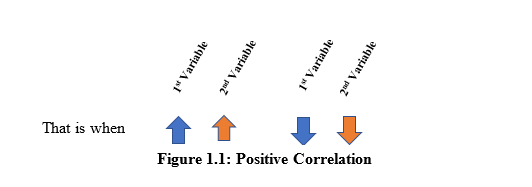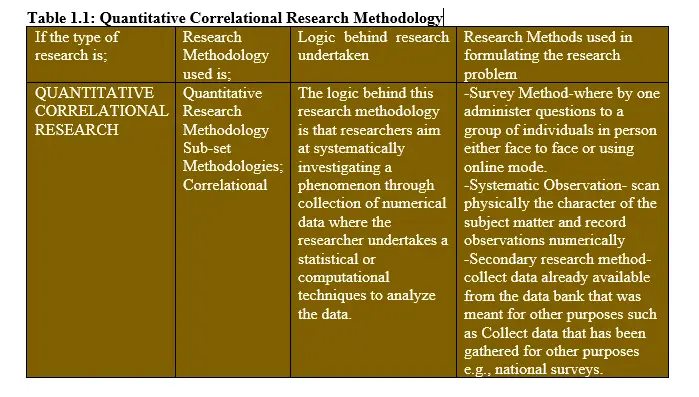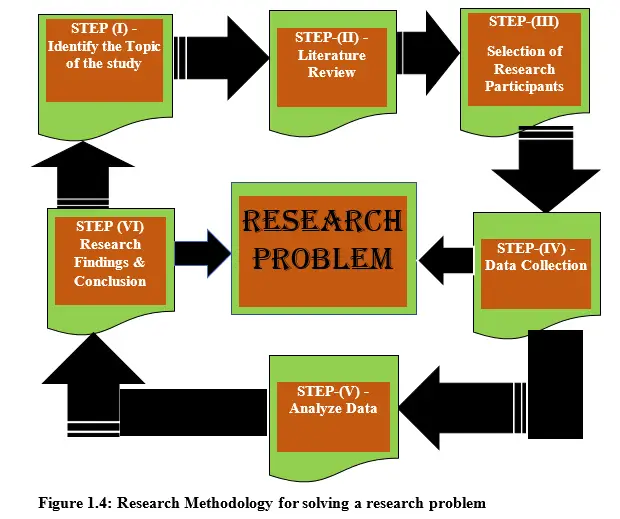Quantitative correlational research: definition, types, methodology, methods, characteristics, examples and advantages
How do we define the term quantitative correlational research? Is it the same as quantitative descriptive research or quantitative causal-comparative? Look at this…
1.1 Definition
Quantitative Correlational Research is a Non-Experimental type of research which involves numerical measurement of variables and investigation of whether the variables correlate and if there is any correlation identified the direction thereof (i.e., direction of the correlation) and finally the strength of the correlation. In other words, quantity correlation research is a design of research which entails observing statistical relationship between two variables in their natural phenomenon. Such that when a variable changes, the other variable change even if not in the same direction.
It should be noted that variables under interrogation are not manipulated by the researcher. This type of research is commonly known as correlational as per the criteria of “quantity perspective”. In our current discussion, we are adding the word “quantitative” so as to portray that the variables are gauged using arithmetic terms.
Types of quantitative correlational research
Types of quantitative correlational research are categorized in to two main classes based on the criteria under consideration.
a). Based on Directional Characteristics
On the basis of direction, there are three main types of quantitative correlation research, namely; positive, negative and zero correlation research. They are further detailed as indicated.
1. Positive Quantitative Correlational Research
The positive correlation research entails investigating two variables which are directly correlated. Such that when one has an increasing change, the other has also an increasing change. Similarly, when the first variable has a declining change, then the other variable which is jointly being compared has a declining change. This correlation is demonstrated in Figure 1.1

NB1: First, in positive quantitative correlational research, the first variable is treated as the independent variable (although it is not) and the second variable as the dependent variable (although it is not) for comparison purposes.
NB2: Second, in positive quantitative correlational research, if the second variable is treated as the independent variable (although it is not) and the first variable as the dependent variable (although it is not) for comparison purposes, the relationship will remain the same as indicated in Figure 1,1b

In conclusion, the in positive quantitative correlation research, there are no clear boundaries between independent and dependent variable. In other words, none of the variables under consideration is distinctly the independent variable or dependent variable. So, either way, the results are always the same. It is just a mere association.
2. Negative Quantitative Correlational Research
The negative correlation research entails investigating two variables which are inversely related or associated. Such that when one has an increasing change, the other has also a decreasing change. Similarly, when the first variable has a declining change, then the other variable which is jointly being compared has an increasing change. This correlation is demonstrated in Figure 1.2

NB1: First, in negative quantitative correlational research, the first variable is treated as the independent variable (although it is not) and the second variable as the dependent variable (although it is not) for comparison purposes.
NB2: Second, in negative quantitative correlational research, if the second variable is treated as the independent variable (although it is not) and the first variable as the dependent variable (although it is not) for comparison purposes, the relationship will remain the same as indicated in Figure 1,2b

In conclusion, the in negative quantitative correlation research, there are no clear boundaries between independent and dependent variable. In other words, none of the variables under consideration is distinctly the independent variable or dependent variable. So, either way, the results are always the same. It is just a mere association.
3. Zero Quantitative Correlational Research
The zero correlation research entails investigating two variables which are not associated or linked at all. Such that when one has an increasing change, the other has no change at all. Similarly, when the first variable has a declining change, then the other variable which is jointly being compared has again no change at all. This correlation is demonstrated in Figure 1.3

NB1: First, in zero quantitative correlational research, the first variable is treated as the independent variable (although it is not) and the second variable as the dependent variable (although it is not) for comparison purposes.
NB2: Second, in zero quantitative correlational research, if the second variable is treated as the independent variable (although it is not) and the first variable as the dependent variable (although it is not) for comparison purposes, the relationship will remain the same as indicated in Figure 1,3b

In conclusion, the in zero quantitative correlation research, there are no clear boundaries between independent and dependent variable. In other words, none of the variables under consideration is distinctly the independent variable or dependent variable. So, either way, the results are always the same. It is just a mere association.
b). Based on Method of Data Collection
Correlational research can also be classified based on data collection methods. Based on this approach, there are three types of correlational research namely;
1. Naturalistic observation research
This is a type of quantitative correlational research which is dominated by data collected in a natural phenomenal state of the study subject.
2. Survey research
This is a type of quantitative correlational research which is dominated by data collected using survey instruments which are distributed to the respondents.
3. Archival research.
This is a type of quantitative correlational research which is dominated by data collected from past data or data bank. It is historical in nature.
Quantitative correlation research methodology
Does quantitative correlational research methods for formulating a research problem the same as quantitative correlational research method for data analysis? The answer is NO. Look at the definitional differences as per our explanation below.
3.1 Definition
Quantitative Correlational Research Methodology is the reasonable progression or step by step design on how to solve a research problem through gathering of the relevant information. Quantitative Correlational Research methodology entails selection of logical procedure on the topic to be studied. That is the research problem, how specific objectives will be identified/or formulated. Identification of knowledge gaps to be filled, research hypotheses to construct, the methods utilized to identify population and sample size, nature of data to be collected and how it will be analyzed, data presentation and interpretations thereof and the reporting of the research findings.
The aforementioned description on quantitative correlational research methodology is in line with the argument of (Kothari, 1984) who was of the idea that research methodology is the foundation behind the methods we use in the context of our research study. This provides a logic as to why one is using a particular method or technique at a particular stage in the research process and not others so that research output is accomplished as expected.
3.2 Questions Quantitative Correlational Research Methodology tries to Answer
Correlational Questions related to this study are for instance, “What are the repercussions of inappropriate reading behavior in examination performance?” This is a question to do with the level of correlation between reading behavior and academic performance. This is an example of a correlational study in which the researcher is primarily concerned with describing relationships between two variables, without seeking to establish a cause-effect association. So, this study tries to answer What kind of questions. Other examples are;
“What is the reward to whoever identifies the culprit who killed Samuel’s grandmother?” this portrays the relationship between the first person to see or identify the culprit and the reward to be given. But you see, this is just a relationship between seeing the culprit and the reward. But it does not mean that the reward caused the culprit to come out or one person to identify him.
The following matrix depicts the link between quantitative correlational type of research and the type of research methodology adopted and then a clarification of the rational approach linked with this type and then in the last column, the research method(s) used in formulating the research problem. Remember these methods are specifically for quantitative correlation research which is a sub-set of Quantitative research.

3.3 Quantitative Correlational Research Methodology-Diagrammatic Approach
The following diagram represents a summary of logical roadmap to be adhered to in quantitative correlational research methodology where Quantitative or Numerical methods are used to measure/gauge the study variables. See Figure 1.4 below

3.4 Logical Steps; Basic Research Methodology
The following logical steps describe the Quantitative Correlational Research methodology. From step one to six, it represents a logical way of how systematically the subject matter need to be dealt with. Remember that in this approach, the researcher is only curious of establishing how variables correlate with one another and the nature of the link.
Step 1: Identify the Topic of the study
The topic of the study should be pegged on the research problem in the mind of the researcher or the investigator. At this stage, the researcher chooses the variables to be studied in a logical manner for the aim of the study is to investigate the relationship between two or more variables or and also testing of hypotheses. So, the choices of variables made must be making sense or be plausible. Further, it should be noted that the link identified by the researcher can be either comprehensive (explanatory correlational) or predictive (futuristic predicting). Let’s look at the two examples
Example-1, the topical issue can be comprehensive such as “what is the relationship between wealth and eating habits of aged men”
Example-2, the topical issue can be futuristic predicting such as “could family background be connected with her heart failure problems?”
Once the topic has been constructed, the next step is to review literature.
Step 2: Literature Review
The researcher has to undertake literature review which is a process of re-visiting the past literature which is related to similar studies addressing the same variables. This approach helps the researcher to interpret the correlation coefficient gotten in those past studies. The review aid in identification of the contextual, methodological and conceptual or theoretical research gaps which is the impetus for the current quantitative correlation research.
Step 3: Selection of Research Participants
Sampling technique is common in selection of the appropriate sample size for the study. The researcher will choose the relevant participants based on the correct sample size. You should note that if wrong sampling technique is used, then this will translate to invalid data and unreliable results will be arrived at. Again, it is fair enough to use a large sample to correctly represent the whole population.
Step 4: Data Collection
This is the stage of garnering the relevant information for analysis purposes so as to arrive at a reliable inference. The researcher has to ensure that data collected appropriately narrates or describes the variables of interest. This can be achieved by carrying out a confirmatory test where by a second party confirmation is done to ensure that the scores arrived at are as stated. For example, if the researcher is collecting data on a certain disease, he can collect data from the patients themselves and also confirm the same/similar data with the concerned doctor.
Illustration
When the data is compiled into a database or spreadsheet, the scores are paired accurately for each participant. That is the patients’ and the doctor’s report should match.
Step 5: Data Analysis
Data analysis for correlation is commonly undertaken using Pearson’s correlation model where by the output is Pearson’s Product Moment Correlation Coefficient (r). The coefficient portrays the nature of correlation between two variables, whether it is positive, negative or no relationship at all or weak or strong. You should note that the weakness or strength of the relationship may not be dictated by the size of the coefficient score. Why? This is because, sometimes the amount of data collected by the researcher may be dismal hence may not really represent the whole population. Cohen (1988) provided a solution to this challenge of small coefficient size by portraying the recommended correlation coefficients as follows;
Coefficient range between .10 to .29 is a weak correlation.
Coefficient range between .30 to .49 is a moderate correlation.
Coefficient range between .50 up to 1.00 is a strong correlation.
So, Cohen (1988) solved the statistical cases where the coefficient of correlation is reasonably low for it may not necessarily imply that the relationship is a weak one.
Step 6: Research Findings and conclusions
In this step, the researcher has performed correlational data analysis and the outcome is ready for reporting and provision of conclusions. In this stage, the researcher has established whether there is positive, negative or no correlation. It is then at this point where he/she infers whether changes in one variable is followed by another change with the other variable. It is at this point where the researcher will abandon the variables if they portray zero correlation or suggest further research of cause-effect nature.
Quantitative correlational research methods
4.1 Definition
Research methods are the procedures that are applied in all the phases of research developments. They are apparatuses used to guarantee the end consequences of research task are accomplished. These techniques vary from one stage of research process to another. These methods are further classified in to two categories, namely;
a) Pre-Data analysis methods
b) Data Analysis related methods
As per Table 1.1 in this article, Quantitative Correlational Research methods indicated in that table (refer), namely survey, systematic observation and secondary research methods are for the purposes of formulating the research problem and are some of the methods which fall under pre-data analysis category. However, in this discussion of quantitative correlational research, we will focus first on the THREE main methods of data collection which are also pre-data analysis in nature. These methods are namely; Naturalistic Observation, Archival Data and Survey Method.
Naturalistic Observation Method
As the name suggests, in this method, the researcher watches the behavior of the subject matter for a certain period. The subject under observation can be either human beings or otherwise in their natural or physical phenomenon. The researcher follows closely the link of the variables being studied for a while before noting what he/she wants to observe. The approach used by the investigator is cautious for the subject matter should not notice whether there is any one following his/her daily activities. Hence the method is extra ordinarily demanding. However, one of the advantages of this approach is that it allows the researcher to fully observe the subjects (variables) in their natural state.
Archival Data Method
The term archival originates from the word archive or store. Now, this method involves collecting data from already gathered information about the variables of interest. The data already in existence is historical for it has been gathered by other researchers for their own use. With this method, the researcher can take advantage of the already drawn statistical trend of the variables of interest which he/she chooses to assess the correlations thereof. It is a method that is cheap to manage and it is also time saving to the researcher.
Survey Method
The survey method is another approach of collecting data under quantitative correlational research. It entails dispensing of survey instruments to the respondents who fill them and return as per the instructions given therein. The process of dispensing the instrument entails random sampling of the variables or the subjects in the research in which the participants fill a questionnaire centered on the topic of interest. The method is not stringent and this makes the researcher gather large amounts of data within a short period.
Characteristics of quantitative correlational research
- Non-experimental in nature-no manipulation of the study variables.
- Data is collected in the natural phenomenon.
- Aim of this type of research is to investigate on correlation between two variables.
- Variables are measured in numeric way.
- Correlation is dynamic- the relationship between variables at one point change as time moves on such that after a certain time the relationship may be different.
- Correlational but NOT The quantitative correlational research simply portrays that there is alternating changes between the two variables under investigation but it does not mean that one variable causes the other to change.
Advantages of quantitative correlational research
- Non-bias data hence results gotten are valid. The fact that there is no manipulation of variables, it means that there is no biased figure of the researcher.
- It is the foundation of causal-effect related research. This type of research is what lays the basis for causal-effect research which is more advanced.
- It is easy to predict the outcome of the hypothesis being tested. This is because the correlational link between or amongst variables gives the researcher a hint on the hypothesis test outcome.
Disadvantages of quantitative correlational research
- Costly
- Time consuming.
- Cannot predict causal-effect relationships between variables.
- Extraneous variables may portray non-sense relationship (i.e., porous relationship).